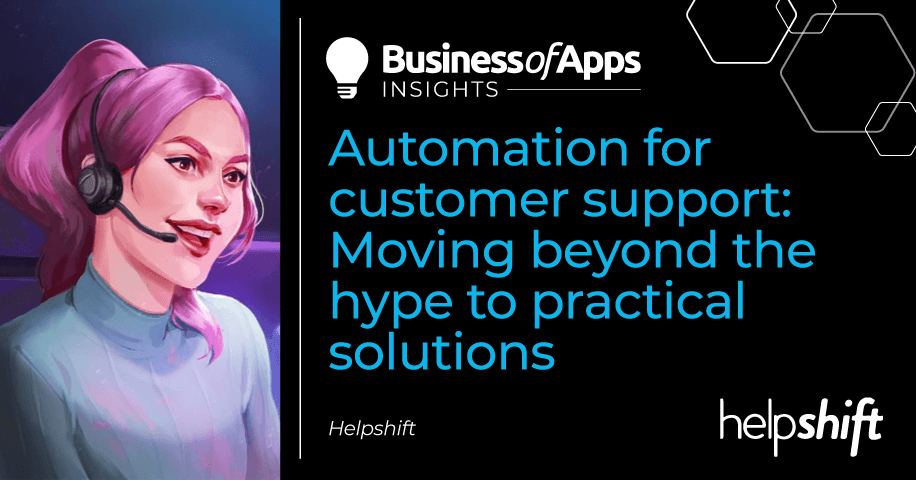Automation is nothing new for the customer experience (CX) industry, but ChatGPT and generative AI have brought a higher level of new attention to the potential of automation for customer service. There’s a lot of hype around ChatGPT and generative AI solutions for how they could replace all human customer service reps. Are we heading toward a future where everything is automated, where all-powerful AI is at the center of the entire customer experience, and where people aren’t needed at all?
The reality of automation for customer support is more complicated and less dramatic than this AI hype cycle would suggest. Most types of customer service automation are not flashy; they tend to blend into the background. For example, online self-service and getting questions answered with automated chatbots are two ways for customers to help themselves without having to speak to a real person.
But instead of replacing humans with automation, there is strong potential today for CX organizations to evolve their customer support strategies and increase the sophistication of their customer support work – with humans and AI working together to add more value to the larger enterprise.
Part of this evolution of automation for customer support needs to include a changed perspective on the value of customer support. Too often, business leaders view customer support solely as a transaction, where support teams get evaluated based on how quickly they can end conversations with customers. Customer support situations shouldn’t be treated as one-time interactions where the goal is to “get rid” of your customer as fast as you can. Instead, customer support should become an engine of long-term customer engagement and a strategic channel for deepening customer relationships.
Along with providing self-service for quick answers to questions, automation can help your organization create deeper engagement with customers. What happens when a customer contacts your company with questions, or when someone has an issue or wants to offer feedback? Instead of just “ending each call as fast as possible,” automation can help your customer service team go deeper and add more value for customers. Instead of just “support reps” or “question answerers,” your CX team can use automation to become Brand Ambassadors and Customer Engagement Creators.
Here are a few key strategies for CX leaders to evolve the support team’s role – with the power of automation – to increase customer engagement and generate more value for everyone.
Create new metrics for the customer support team
Traditional metrics for the customer support team have been focused on “how quickly can we end this phone call and make the customer go away.” These metrics, such as “average handle time,” “average speed of answer,” or “average talk time,” were developed in an era when emails and phone calls were the main ways of solving customer problems. But that’s not good enough anymore, especially with the new opportunities of automation. Instead of evaluating your CX team based on obsolete metrics, CX leaders need to find new ways of showing how these teams add value, in ways that go beyond “how fast can we get rid of the customer.”
For example, what if there was a next-generation CX metric for “total engagement time vs. CSAT?” This would be a survey-based measurement of how customers feel about your brand, mapped against the total depth of engagement – not just the length of a phone call. Instead of measuring “how quickly did we get rid of the customer,” CX teams should measure – and be rewarded for – “how effectively did we improve and deepen that customer relationship?”
Use automation for asynchronous conversations and low-touch solutions
Automation for customer support doesn’t have to sound like a robot. Instead, automation can be highly effective at leveraging contextual information, verifying the customer’s identity, and creating a more personalized conversation between the customer and the brand. Build automation into your workflows to solve customer problems quickly, but in a low-touch, asynchronous way that doesn’t require the customer to spend time on hold.
Ultimate App Growth Guide 2025
Boost your app’s success with the Ultimate App Growth Guide! 🚀 Expert insights, proven strategies & must-know tips. Download now!
Master app growthFor example, you have a customer who is signed up for autopay but gets an unpleasant surprise – their monthly bill from your company is higher than they expected. This makes the customer upset. After calling your customer support phone number and spending 45 minutes on hold, the customer finally gets an answer from your call center support rep: “Sorry, but that billing amount was correct. You recently have been using our service more than usual, so your higher monthly usage bumped you into a higher price-point.”
Even if the measurable “average talk time” for this interaction was low, does this sound like a successful customer support experience to you? Of course not. This was a missed opportunity for the company. Because the customer lost 45 minutes out of their busy day and still didn’t get a satisfactory solution.
There is a better way to support customers, with the power of automation, that results in a better solution and a happier customer.
Instead of making every customer call the customer support line and wait on hold and navigate multiple menus, let’s assume that the brand in this story had a few automation solutions in place: AI automation, in-app messaging, and pre-established business rules for how to segment and manage higher-priority customers.
Let’s start again from the beginning: the customer recognizes a discrepancy with their bill. The customer opens the brand’s mobile app and contacts customer support via messaging:
Customer: “My bill is $25 more than I usually pay.”
The AI is trained to recognize this message and categorize the customer’s incoming requests. It understands that the customer is contacting the company because of an issue with “overpayment.”
Next, the AI creates an automated response: “Sorry, I understand that you have concerns about a possible overpayment. Based on your recent account history, you’ve been using our service more than usual, and you were re-assigned into the ‘high-usage’ plan for that month. That’s why your bill is higher than usual, but the amount is correct.”
Now the customer has received an answer to explain the situation, without waiting on hold. However, this customer is still unhappy. They’ve been a long-time customer and they want a solution that rewards their loyalty.
Customer: “OK, but I didn’t receive any notification about this higher payment amount. I am going to cancel my account.”
The AI knows the customer’s history and has been pre-trained to make special offers to retain long-time customers.
AI: “We appreciate your business and I know you’re a loyal customer. I’m happy to offer you a 5% discount on this new plan. Is this OK with you?”
Result: The customer gets a positive resolution to their problem, without having to sit on hold, in a low-touch process via asynchronous chat messages. The customer could’ve put their phone down, walked away, and come back to the chat at their convenience, without worrying about losing their place in line.
Instead of putting your customers on hold and eating up hours of their day, your customer support journeys can use automation to be more asynchronous and mobile app-first. Customers don’t always need the fastest answer or the shortest phone call. Instead, they need a happy resolution and personalized support that saves them time and effort.
Automation plus people: Emphasizing the human element
Automation can be built into your CX journeys and workflows to help your human support team deepen relationships with customers. Look for ways to use automation to learn more about your customers, understand your customers’ intent, and improve your customer segmentation. Then you can set up your support team for success, with more meaningful interactions based on insights to deepen the relationship with each customer.
Don’t use customer support to shoo customers away. Instead, embrace the opportunity to use customer support conversations as strategic touchpoints for customer segmentation, customer insights, and deeper engagement. CX teams have an opportunity to use automation to do more of what people do best, serve as helpful brand ambassadors and drive long-term customer lifetime value.












